For many dog owners, the thought of managing a long training leash can seem daunting. I confess, I was initially one of them. With my first dog, Mia, who had excellent recall from puppyhood, a long training leash was never a necessity. However, when Zulu joined our family, her independent nature and upbringing outside a city environment meant that I heavily relied on a dragline, a type of long training leash, during her initial months. This experience opened my eyes to the diverse advantages and potential pitfalls of using a Long Training Leash For Dogs, far beyond what I had imagined.
This article aims to explore these various scenarios, delve into the specific risks associated with long lines, and provide practical guidance on how to decide when and how to effectively and safely incorporate a long training leash into your dog’s routine. Whether you’re working on recall, exploring new environments, or simply providing more freedom, understanding this essential piece of equipment is key.
The long training leash discussed and pictured in this article is a durable Biothane Long Line from Henry and Sadie. It measures 1/2 inch (1.3 cm) wide and 15 feet (4.5 meters) long, designed without a handle for specific training applications. If you’re preparing for a new furry family member, understanding various dog training tools is as crucial as gathering your supplies needed for new puppy to ensure a smooth transition.
What is a Long Training Leash for Dogs, and Why Use One?
At its core, a long training leash for dogs, often simply called a long line or long lead, is an extended version of a standard leash, typically ranging from 10 to 50 feet or more, and can come with or without a handle. These versatile leashes are primarily used to provide dogs with more freedom to explore while maintaining a level of safety and control, making them indispensable for off-leash training, recall practice, and managing dogs in open, non-fenced areas.
Long training leashes are commonly made from various materials, each with distinct properties:
- Rope/Fabric Leashes: These are generally lightweight and flexible. However, a significant drawback is the potential for severe “rope burn” if a handler or another dog gets tangled while the dog is running at speed. They can also degrade over time, especially with exposure to elements like sand, which can fray the material.
- Biothane Leashes: Increasingly popular, Biothane is a synthetic material known for its excellent durability. It’s waterproof, exceptionally easy to clean (a quick wipe often suffices), doesn’t absorb odors, and is highly resistant to damage from abrasive elements like sand and rough terrain. Its smooth surface also reduces the risk of rope burn compared to traditional ropes, making it a preferred choice for many trainers and owners using a long training leash for dogs.
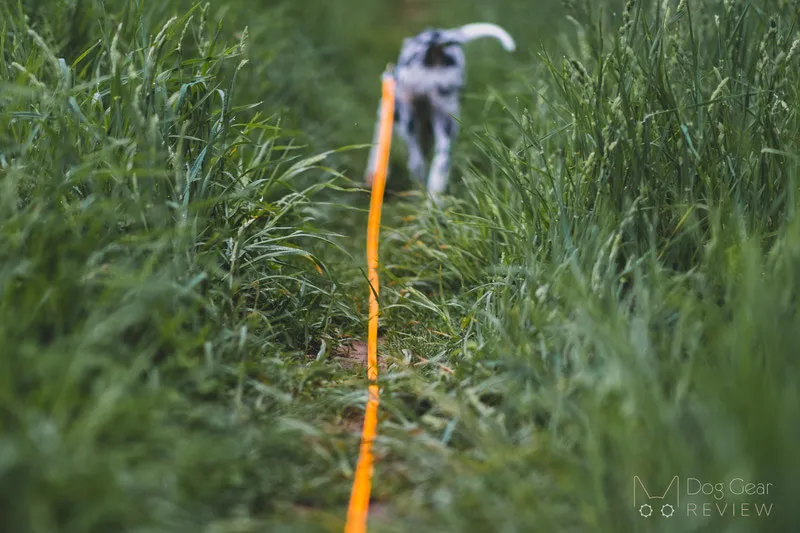 A Golden Retriever mix dog on a yellow Biothane long training leash, running in an open field.
A Golden Retriever mix dog on a yellow Biothane long training leash, running in an open field.
Using a Long Leash as an Extended Leash (Beyond Retractables)
Some dog owners opt to use a long training leash as an extended walking leash, managing its length by hand rather than relying on a retractable leash. While we won’t delve deeply into the broader debate of retractable leashes here (as we’ve previously covered this topic), it’s important to consider why a static long line might be chosen instead.
The optimal leash choice always hinges on the specific environment, the individual dog’s temperament, and the handler’s leash skills. A calm dog might comfortably amble through an open field with some of the long line trailing, but navigating a high-energy dog in a bustling city environment while managing significant leash slack can be considerably more challenging.
Retractable leashes offer the convenience of automatically taking up slack, allowing for quicker reactions. With a long training leash used as an extended lead, you must constantly manage the length to prevent entanglement and maintain effective control. If you merely hold the end of a long line and allow the middle to drag, a dog might suddenly bolt after wildlife or burst into a sprint, only to be abruptly yanked back when they reach the leash’s full extension. This can result in serious injuries to both the dog’s neck/spine and the handler.
While a long training leash truly shines in open, expansive areas, offering your dog ample room to explore safely, it can become impractical and even hazardous in crowded urban settings. Furthermore, managing multiple dogs on separate long lines simultaneously can be complicated, whereas retractable leashes allow for one-handed operation per dog. For those considering their initial puppy food and water bowls, remember that choosing the right training equipment, like a long training leash, is just as vital as their feeding essentials.
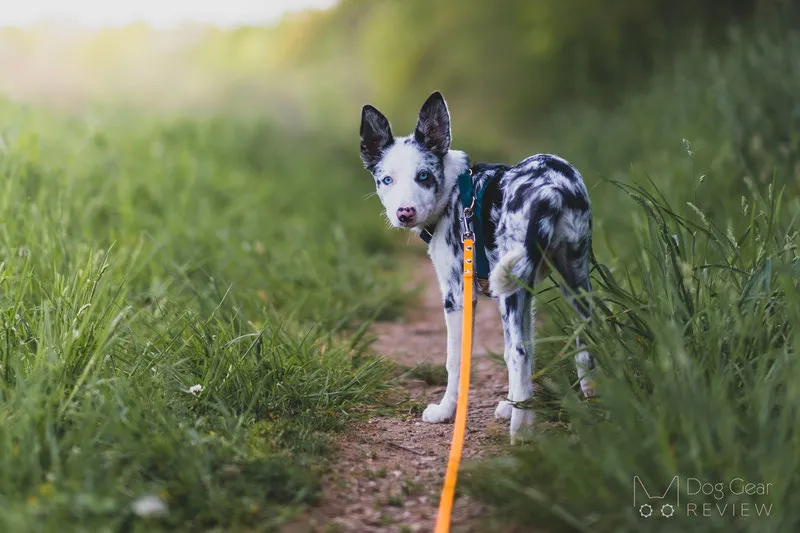 A dog walker managing a long training leash for their dog walking calmly on a path, demonstrating controlled extension.
A dog walker managing a long training leash for their dog walking calmly on a path, demonstrating controlled extension.
The Dragline Technique: Enhancing Off-Leash Skills
A “dragline” is a specific application of a long training leash where it’s attached to the dog’s collar or harness and allowed to trail behind them without being held by the owner. This technique offers a crucial safety net for dogs who are still developing reliable recall or those with a strong prey drive, as it provides an opportunity for the owner to quickly grab or step on the leash if the dog decides to chase after something instead of returning when called.
For dogs with an intense prey drive, a dragline can be a valuable tool, but it comes with caveats. If the dog takes off unexpectedly, grabbing the trailing leash might be difficult or impossible before they get too far. There’s also the risk of the leash getting tangled in dense brush or trees, potentially trapping the dog or causing injury if they pull hard against a sudden snag. Therefore, careful consideration of the environment is paramount.
Ideally, draglines should be lightweight and thin, often without a handle, to minimize the leash pressure on the dog and reduce the likelihood of getting caught on obstacles. Using a regular, heavy leash as a dragline can quickly ruin it, as they aren’t designed to withstand constant dragging through mud, rocks, and rough terrain, leading to rapid fraying and damage.
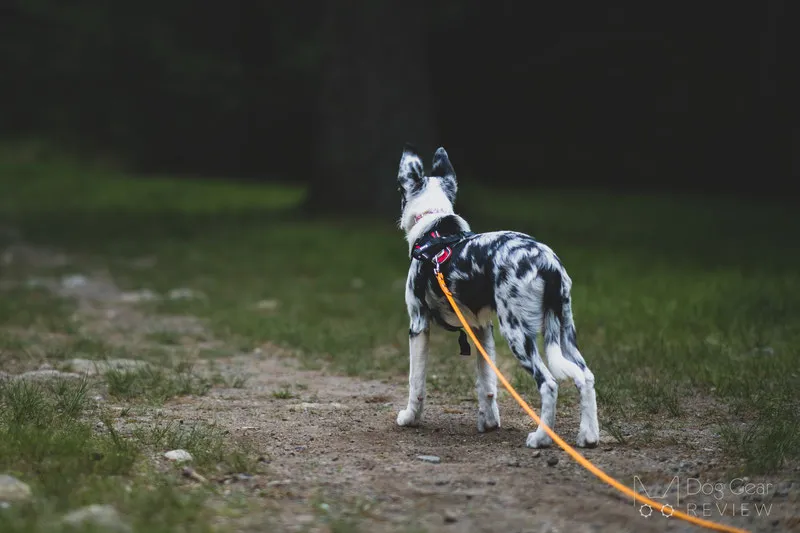 A dog dragging a thin, lightweight long training leash (dragline) across a grassy field.
A dog dragging a thin, lightweight long training leash (dragline) across a grassy field.
Potential Risks of Using a Long Training Leash as a Dragline
In recent years, the use of draglines has surged as a popular method for teaching off-leash skills to puppies and newly adopted adult dogs. While undeniably effective tools, it’s critical to be fully aware of their potential downsides and dangers. Many users view long lines as merely a comfortable backup, often overlooking their long-term adverse effects or the crucial steps needed to minimize associated risks.
Tangles and Injury Hazards
Despite wider leashes and Biothane lines being less prone to causing severe rope burn than thinner ropes, the risk still exists. It can be particularly annoying, and even hazardous, when a dog on a long training leash suddenly rushes past on a trail or zigzags around people, potentially entangling passersby. More seriously, dogs playing together while one is dragging a long line can lead to dangerous tangles. If the leash wraps around a leg or tightens around the body as dogs run, it can cause severe injuries, including cuts, sprains, or even fractures.
Furthermore, using a dragline near or in water activities such as swimming, kayaking, or paddleboarding carries significant risks. If the long training leash gets snagged on an underwater object, it can trap the dog, potentially leading to drowning, especially in fast-moving currents or if the dog is not wearing a life vest. Safety should always be the top priority when introducing your dog to water with a dragline. Providing dogs with proper and safe dog pens for sale near me can also offer a controlled environment for training, reducing the need for constant dragline supervision in certain contexts.
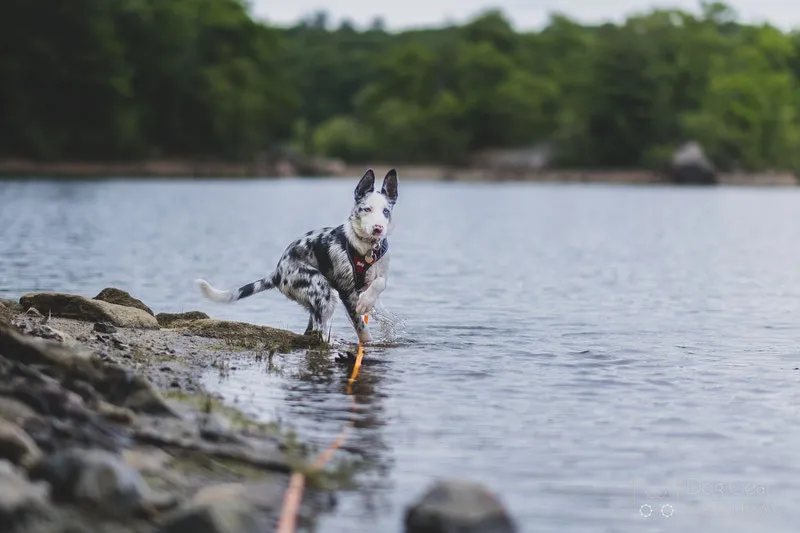 A dog in a river with a long training leash trailing in the water, highlighting potential entanglement risks.
A dog in a river with a long training leash trailing in the water, highlighting potential entanglement risks.
Collar Attachment Risks
Attaching a long training leash directly to a dog’s collar, especially when used as a dragline or if the dog reaches the end of the line at high speed, poses a significant risk of neck injury. This sudden jolt can occur if the handler is holding the end and the dog pulls hard, or if the leash gets caught on an obstacle in the woods, or if someone accidentally steps on it. Such impacts can cause serious damage to the dog’s trachea, larynx, or cervical spine.
Another often overlooked issue is how a trailing dragline can affect a dog’s natural gait. Since the leash runs under the dog’s body, many dogs learn to “spread out” their legs or walk at an angle to avoid stepping on it. While this might merely be uncomfortable for some, it can lead to developmental problems in young puppies whose joints are still forming. Forcing an unnatural gait over an extended period can contribute to long-term orthopedic issues that may not manifest immediately.
Harness Attachment Risks
Attaching a long training leash to a harness offers a clear advantage by protecting the dog’s neck from sudden impacts. However, it introduces a different set of challenges. Most soft, Y-front style harnesses (like the one pictured) tend to rotate to one side when a dragline is attached, pulled by gravity and the dog’s movement. This rotation often causes the strap between the front legs to press uncomfortably against the inside of one leg. While some dogs tolerate this slight pressure, for others, it can lead to chafing, skin irritation, or, as observed with Zulu, a significant alteration in gait, causing them to walk sideways or even hop to avoid the awkward feeling of an ill-fitting, rotating harness.
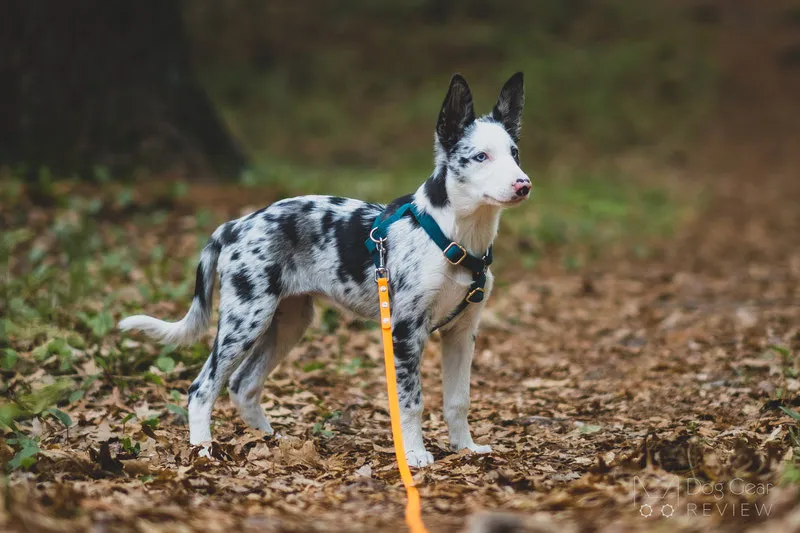 A dog wearing a harness with a long training leash attached, showing how the harness can shift due to leash pressure.
A dog wearing a harness with a long training leash attached, showing how the harness can shift due to leash pressure.
For a deeper understanding of proper harness fit and how to identify if a harness restricts your dog’s natural movement, we have a detailed article on well-fitting harnesses. To mitigate the rotation issue when using a long training leash, harnesses with more rigid neck and back pieces generally stay in place better. Examples include the Musher Freespirit Harness, the Non-stop Dogwear Line Harness, and the CTC Dog Gear Shoulder Harness. Some harnesses also feature a leash attachment point located under the rib cage (such as certain Non-stop Dogwear short harnesses), which allows the long line to be attached underneath the dog, effectively preventing harness rotation and causing minimal disruption to the dog’s natural movement.
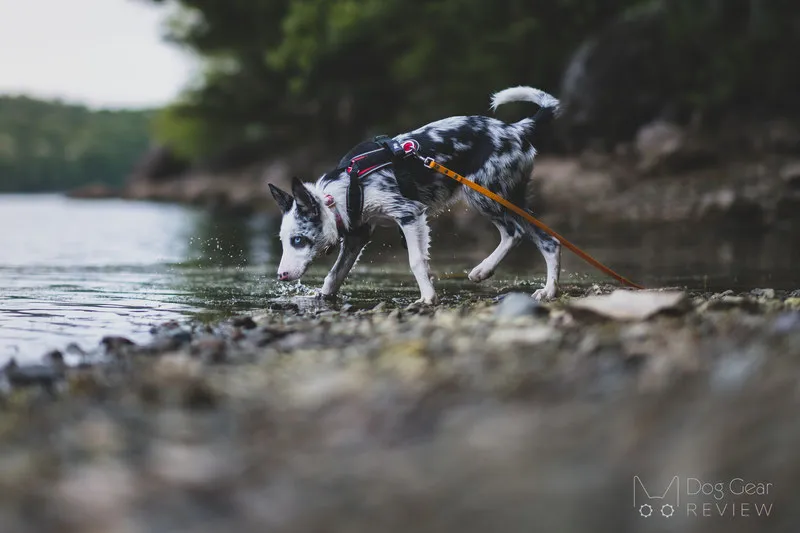 A dog wearing a well-fitting, rigid harness that prevents rotation, suitable for use with a long training leash.
A dog wearing a well-fitting, rigid harness that prevents rotation, suitable for use with a long training leash.
Balancing Benefits and Risks for Safe Long Leash Use
Long training leashes, particularly when used as draglines, are undoubtedly valuable tools in a dog owner’s arsenal. However, their use should be a deliberate and informed decision. Whenever feasible, the goal should be to pair dragline use with consistent training, gradually phasing out the long line as your dog’s recall and off-leash reliability improve. In situations where phasing out isn’t realistic, it’s crucial to acknowledge the inherent risks and proactively implement measures to ensure the safety of both your dog and those around them.
Prioritize environments where a dragline can be used safely, free from entanglement hazards or dense obstacles. Choose the appropriate equipment – a lightweight, durable Biothane line is often ideal, and pair it with a well-fitting harness that minimizes rotation and protects your dog’s physical well-being. By being mindful of these considerations, you can harness the full potential of a long training leash for dogs, fostering freedom and reinforcing good behavior while mitigating potential dangers.
Conclusion
Using a long training leash for dogs offers an invaluable bridge to off-leash freedom, enabling effective recall training and safe exploration in open environments. While tools like the Biothane long line provide durability and ease of use, understanding the nuances between using it as an extended leash versus a dragline is crucial. The potential risks, including entanglement, neck injury from collar attachment, and gait disruption from ill-fitting harnesses, highlight the importance of informed decision-making. By carefully selecting your equipment, understanding its proper application, and actively training your dog, you can significantly enhance their safety and confidence. Always prioritize your dog’s well-being and continually assess the environment to ensure that the benefits of using a long training leash outweigh the risks.
For more comprehensive guides on dog care and training, explore other articles on Dog Care Story!
